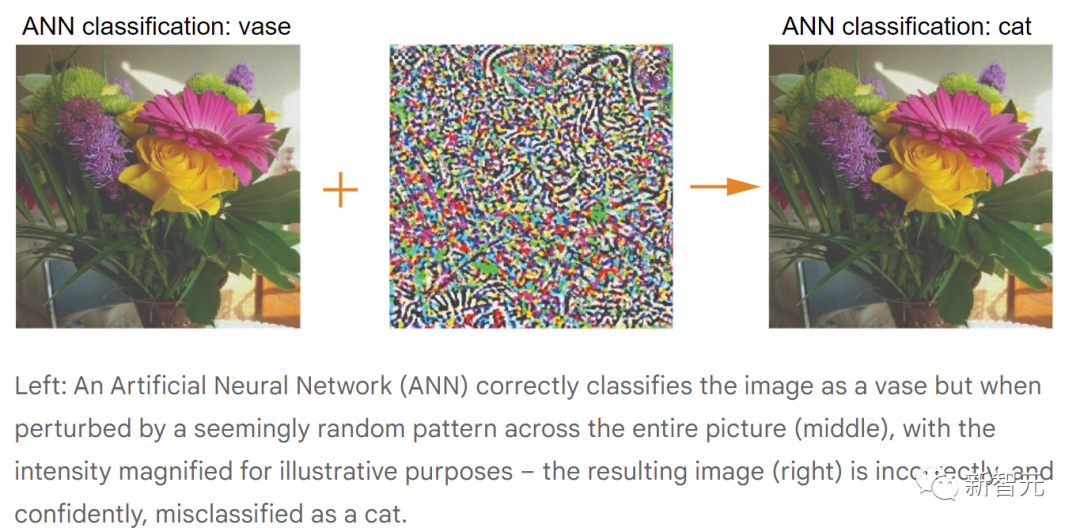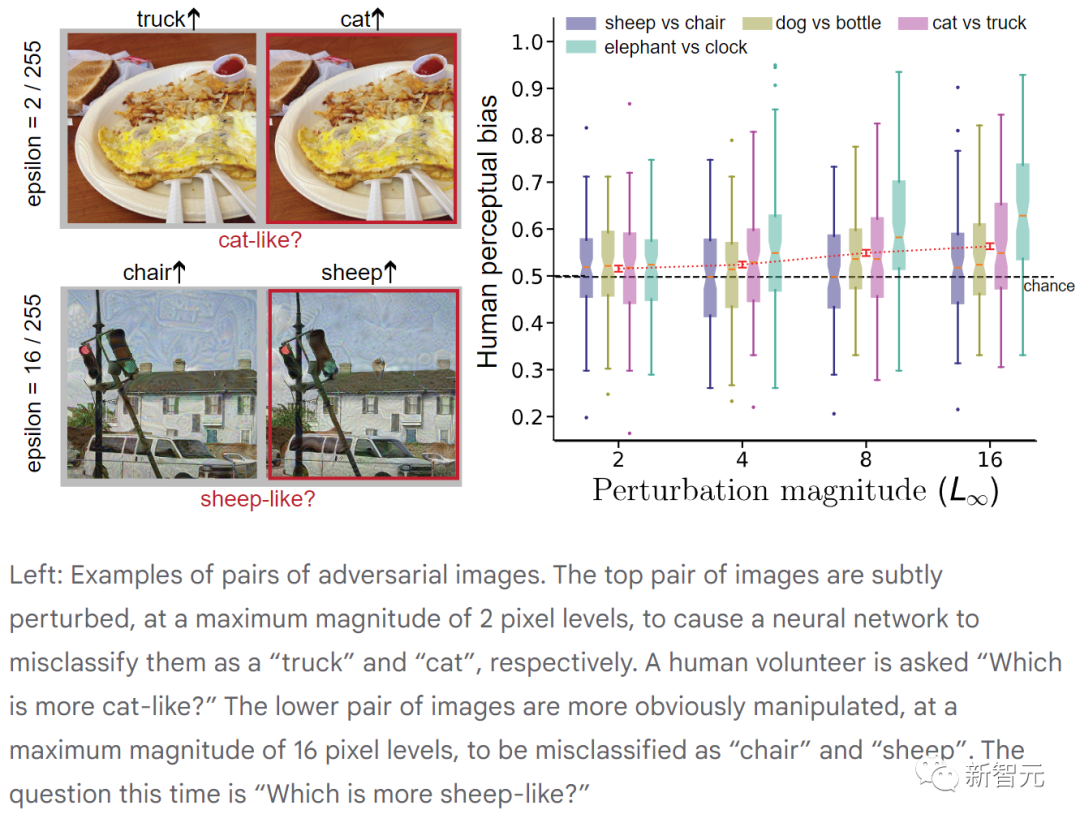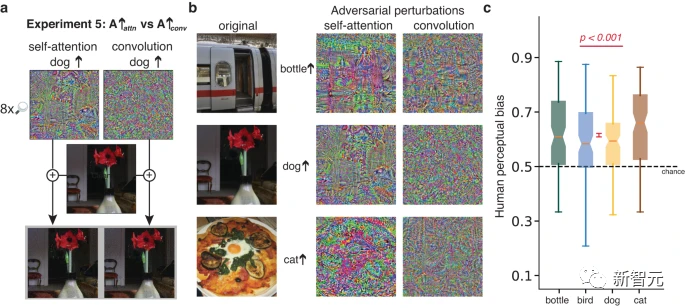 Technology peripherals
Technology peripherals
 AI
AI
 Google DeepMind research found that adversarial attacks can affect the visual recognition of humans and AI, mistaking a vase for a cat!
Google DeepMind research found that adversarial attacks can affect the visual recognition of humans and AI, mistaking a vase for a cat!
Google DeepMind research found that adversarial attacks can affect the visual recognition of humans and AI, mistaking a vase for a cat!
What is the relationship between human neural network (brain) and artificial neural network (ANN)?
A teacher once compared it this way: It’s like the relationship between a mouse and Mickey Mouse.
Real-life neural networks are powerful, but completely different from the way humans perceive, learn and understand.
For example, ANNs exhibit vulnerabilities not usually found in human perception, and they are susceptible to adversarial perturbations.
An image may only need to modify the values of a few pixels, or add some noise data,
From a human perspective, observe There is no difference, and for the image classification network, it will be recognized as a completely unrelated category.
However, the latest research from Google DeepMind shows that our previous view may be wrong!
Even subtle changes in digital images can affect human perception.
In other words, human judgment can also be affected by such adversarial perturbations.

Paper address: https://www.nature.com/articles/s41467-023-40499-0
This article by Google DeepMind was published in Nature Communications.
The paper explores whether humans might also exhibit sensitivity to the same perturbations under controlled testing conditions.
Through a series of experiments, the researchers proved this.
At the same time, this also shows the similarities between human and machine vision.
Adversarial images
Adversarial images are subtle changes to an image that cause the AI model to misclassify the image content, - This type of deliberate deception is called an adversarial strike.
For example, an attack could be targeted to cause an AI model to classify a vase as a cat, or as anything other than a vase.

The above figure shows the process of adversarial attack (for the convenience of human observation, the random perturbations in the middle are exaggerated).
In digital images, each pixel in the RGB image has a value between 0-255 (at 8-bit depth), and the value represents the intensity of a single pixel.
For adversarial attacks, the attack effect may be achieved by changing the pixel value within a small range.
In the real world, adversarial attacks on physical objects may also be successful, such as causing a stop sign to be mistakenly recognized as a speed limit sign.
So, for security reasons, researchers are already working on ways to defend against adversarial attacks and reduce their risks.
Adversarial effects on human perception
Previous research has shown that people may be sensitive to large-amplitude image perturbations that provide clear shape cues.
However, what impact do more nuanced adversarial attacks have on humans? Do people perceive perturbations in images as harmless random image noise, and does it affect human perception?
To find out, researchers conducted controlled behavioral experiments.
First a series of raw images are taken and two adversarial attacks are performed on each image to produce multiple pairs of perturbed images.
In the animated example below, the original image is classified by the model as a "vase".
Due to the adversarial attack, the model misclassified the two disturbed images as "cat" and "truck" with high confidence.

Next, human participants were shown the two images and asked a targeted question: Which image was more like a cat? ?
Although neither photo looked like a cat, they had to make a choice.
Often, subjects believe that they have made random choices, but is this really the case?
If the brain was insensitive to subtle adversarial attacks, subjects would choose each picture 50% of the time.
However, experiments have found that the selection rate (that is, human perception bias) is actually higher than chance (50%), and in fact the adjustment of picture pixels is very small.
From the participant's perspective, it feels like they are being asked to differentiate between two nearly identical images. However, previous research has shown that people use weak perceptual signals when making choices - even though these signals are too weak to convey confidence or awareness.
In this example, we might see a vase, but some activity in the brain tells us that it has the shadow of a cat.

#The above figure shows pairs of adversarial images. The top pair of images are subtly perturbed, with a maximum amplitude of 2 pixels, causing the neural network to misclassify them as "truck" and "cat" respectively. (Volunteers were asked "Which one is more like a cat?")
The disturbance in the lower pair of images is more obvious, with a maximum amplitude of 16 pixels, and was incorrectly classified by the neural network as " "Chair" and "Sheep". (This time the question was "Which one is more like a sheep?")
In each experiment, participants reliably chose the answer to the target question more than half the time. Confrontation images. While human vision is not as susceptible to adversarial perturbations as machine vision, these perturbations can still bias humans in favor of decisions made by machines.
If human perception can be affected by adversarial images, then this will be a new but critical security issue.
This requires us to conduct in-depth research to explore the similarities and differences between the behavior of artificial intelligence visual systems and human perception, and to build safer artificial intelligence systems.
Paper details
The standard procedure for generating adversarial perturbations starts with a pre-trained ANN classifier that maps RGB images to A probability distribution over a fixed set of classes.
Any changes to the image (such as increasing the red intensity of a specific pixel) will produce a slight change in the output probability distribution.
Adversarial images are searched (gradient descent) to obtain a perturbation of the original image that causes the ANN to lower the probability of being assigned to the correct class (non-targeted attack) or assign a high probability Give certain designated alternative categories (targeted attacks).
To ensure that the perturbation does not deviate too far from the original image, the L (∞) norm constraint is often applied in the adversarial machine learning literature, specifying that no pixel can deviate from its original value by more than ±ε, ε is usually much smaller than the [0–255] pixel intensity range.
This constraint applies to pixels in each RGB color plane. Although this limitation does not prevent individuals from detecting changes in the image, by appropriately choosing ε, the main signal indicating the original image category remains mostly intact in the perturbed image.
Experiments
In the original experiment, the authors studied human response to brief, occluded adversarial images. Categorize responses.
By limiting exposure time to increase classification errors, the experiment was designed to increase an individual's sensitivity to aspects of a stimulus that might not otherwise influence classification decisions.
An adversarial perturbation is performed on the image of the real class T. By optimizing the perturbation, the ANN tends to misclassify the image as A. Participants were asked to make a forced choice between T and A.

The researchers also tested participants on control images, which were obtained in condition A by flipping them top-down. Adversarial perturbation image formation.
This simple transformation breaks the pixel-to-pixel correspondence between the adversarial perturbation and the image, largely eliminating the impact of the adversarial perturbation on the ANN, while retaining the perturbation specification and other Statistical data.
The results showed that participants were more likely to judge the perturbed image as category A compared to the control image.
Experiment 1 above used a brief masking demonstration to limit the influence of the original image category (primary signal) on the response, thereby revealing sensitivity to adversarial perturbations (subordinate signal) .
The researchers also designed three other experiments with the same goals, but avoided the need for large-scale perturbations and limited-exposure viewing.
In these experiments, the dominant signal in the image does not systematically guide response selection, allowing the influence of the subordinate signal to emerge.

In each experiment, a nearly identical pair of unmasked stimuli was presented and remained visible until a response was selected. The pair of stimuli have the same dominant signal, they are both modulations of the same underlying image, but have different slave signals. Participants were asked to select images that more closely resembled instances of the target category.
In Experiment 2, both stimuli were images belonging to the T category. One of them was perturbed, and the ANN predicted that it was more like the T category. The other was perturbed and was predicted to be Not even like a T category.
In Experiment 3, the stimulus is an image belonging to the real category T, one of which is perturbed to change the classification of the ANN, making it closer to the target adversarial category A, and the other One uses the same perturbation but flipped left and right as a control condition.
The effect of this control is to preserve the norm and other statistics of the perturbation, but it is more conservative than the control in Experiment 1, because the left and right sides of the image may have more characteristics than the upper and lower parts of the image. More similar statistics.
The pair of images in Experiment 4 are also modulations of the real category T, one is perturbed to be more like category A, and the other is more like category 3. Trials alternated between asking participants to choose an image that was more like Category A, or an image that was more like Category 3.
In Experiments 2-4, the human perceptual bias of each image was significantly positively correlated with the bias of the ANN. Perturbation amplitudes ranged from 2 to 16, which are smaller than perturbations previously studied on human participants and similar to those used in adversarial machine learning studies.
Surprisingly, perturbations of even 2 pixel intensity levels are enough to reliably affect human perception.

The strength of Experiment 2 is that it requires participants to make intuitive judgments (e.g., which of two perturbed cat images is more like a cat) ;
However, Experiment 2 allows adversarial perturbations to make images more or less cat-like simply by sharpening or blurring them.
The advantage of Experiment 3 is that all statistics of the perturbations compared are matched, not just the maximum amplitude of the perturbation.
However, matching perturbation statistics does not ensure that the perturbation is equally perceptible when added to the image, and therefore, participants may make choices based on image distortion.
The strength of Experiment 4 is that it demonstrates that participants are sensitive to the questions being asked, as the same image pairs produced systematically different responses depending on the question asked.
However, Experiment 4 asked participants to answer a seemingly absurd question (e.g., which of two omelet images looks more like a cat?), leading to question interpretation Variability of manner.
Taken together, Experiments 2-4 provide converging evidence that even very small perturbations with unlimited viewing time can have a strong impact on AI networks The subordinate confrontation signal will also affect human perception and judgment in the same direction.
Furthermore, extending the observation time (naturally perceived environment) is key for adversarial perturbations to have real consequences.
The above is the detailed content of Google DeepMind research found that adversarial attacks can affect the visual recognition of humans and AI, mistaking a vase for a cat!. For more information, please follow other related articles on the PHP Chinese website!

Hot AI Tools

Undresser.AI Undress
AI-powered app for creating realistic nude photos

AI Clothes Remover
Online AI tool for removing clothes from photos.

Undress AI Tool
Undress images for free

Clothoff.io
AI clothes remover

Video Face Swap
Swap faces in any video effortlessly with our completely free AI face swap tool!

Hot Article

Hot Tools

Notepad++7.3.1
Easy-to-use and free code editor

SublimeText3 Chinese version
Chinese version, very easy to use

Zend Studio 13.0.1
Powerful PHP integrated development environment

Dreamweaver CS6
Visual web development tools

SublimeText3 Mac version
God-level code editing software (SublimeText3)

Hot Topics
 1669
1669
 14
14
 1428
1428
 52
52
 1329
1329
 25
25
 1273
1273
 29
29
 1256
1256
 24
24
 How to use the chrono library in C?
Apr 28, 2025 pm 10:18 PM
How to use the chrono library in C?
Apr 28, 2025 pm 10:18 PM
Using the chrono library in C can allow you to control time and time intervals more accurately. Let's explore the charm of this library. C's chrono library is part of the standard library, which provides a modern way to deal with time and time intervals. For programmers who have suffered from time.h and ctime, chrono is undoubtedly a boon. It not only improves the readability and maintainability of the code, but also provides higher accuracy and flexibility. Let's start with the basics. The chrono library mainly includes the following key components: std::chrono::system_clock: represents the system clock, used to obtain the current time. std::chron
 How to understand DMA operations in C?
Apr 28, 2025 pm 10:09 PM
How to understand DMA operations in C?
Apr 28, 2025 pm 10:09 PM
DMA in C refers to DirectMemoryAccess, a direct memory access technology, allowing hardware devices to directly transmit data to memory without CPU intervention. 1) DMA operation is highly dependent on hardware devices and drivers, and the implementation method varies from system to system. 2) Direct access to memory may bring security risks, and the correctness and security of the code must be ensured. 3) DMA can improve performance, but improper use may lead to degradation of system performance. Through practice and learning, we can master the skills of using DMA and maximize its effectiveness in scenarios such as high-speed data transmission and real-time signal processing.
 What is real-time operating system programming in C?
Apr 28, 2025 pm 10:15 PM
What is real-time operating system programming in C?
Apr 28, 2025 pm 10:15 PM
C performs well in real-time operating system (RTOS) programming, providing efficient execution efficiency and precise time management. 1) C Meet the needs of RTOS through direct operation of hardware resources and efficient memory management. 2) Using object-oriented features, C can design a flexible task scheduling system. 3) C supports efficient interrupt processing, but dynamic memory allocation and exception processing must be avoided to ensure real-time. 4) Template programming and inline functions help in performance optimization. 5) In practical applications, C can be used to implement an efficient logging system.
 Steps to add and delete fields to MySQL tables
Apr 29, 2025 pm 04:15 PM
Steps to add and delete fields to MySQL tables
Apr 29, 2025 pm 04:15 PM
In MySQL, add fields using ALTERTABLEtable_nameADDCOLUMNnew_columnVARCHAR(255)AFTERexisting_column, delete fields using ALTERTABLEtable_nameDROPCOLUMNcolumn_to_drop. When adding fields, you need to specify a location to optimize query performance and data structure; before deleting fields, you need to confirm that the operation is irreversible; modifying table structure using online DDL, backup data, test environment, and low-load time periods is performance optimization and best practice.
 How to measure thread performance in C?
Apr 28, 2025 pm 10:21 PM
How to measure thread performance in C?
Apr 28, 2025 pm 10:21 PM
Measuring thread performance in C can use the timing tools, performance analysis tools, and custom timers in the standard library. 1. Use the library to measure execution time. 2. Use gprof for performance analysis. The steps include adding the -pg option during compilation, running the program to generate a gmon.out file, and generating a performance report. 3. Use Valgrind's Callgrind module to perform more detailed analysis. The steps include running the program to generate the callgrind.out file and viewing the results using kcachegrind. 4. Custom timers can flexibly measure the execution time of a specific code segment. These methods help to fully understand thread performance and optimize code.
 Top 10 digital currency trading platforms: Top 10 safe and reliable digital currency exchanges
Apr 30, 2025 pm 04:30 PM
Top 10 digital currency trading platforms: Top 10 safe and reliable digital currency exchanges
Apr 30, 2025 pm 04:30 PM
The top 10 digital virtual currency trading platforms are: 1. Binance, 2. OKX, 3. Coinbase, 4. Kraken, 5. Huobi Global, 6. Bitfinex, 7. KuCoin, 8. Gemini, 9. Bitstamp, 10. Bittrex. These platforms all provide high security and a variety of trading options, suitable for different user needs.
 Quantitative Exchange Ranking 2025 Top 10 Recommendations for Digital Currency Quantitative Trading APPs
Apr 30, 2025 pm 07:24 PM
Quantitative Exchange Ranking 2025 Top 10 Recommendations for Digital Currency Quantitative Trading APPs
Apr 30, 2025 pm 07:24 PM
The built-in quantization tools on the exchange include: 1. Binance: Provides Binance Futures quantitative module, low handling fees, and supports AI-assisted transactions. 2. OKX (Ouyi): Supports multi-account management and intelligent order routing, and provides institutional-level risk control. The independent quantitative strategy platforms include: 3. 3Commas: drag-and-drop strategy generator, suitable for multi-platform hedging arbitrage. 4. Quadency: Professional-level algorithm strategy library, supporting customized risk thresholds. 5. Pionex: Built-in 16 preset strategy, low transaction fee. Vertical domain tools include: 6. Cryptohopper: cloud-based quantitative platform, supporting 150 technical indicators. 7. Bitsgap:
 How does deepseek official website achieve the effect of penetrating mouse scroll event?
Apr 30, 2025 pm 03:21 PM
How does deepseek official website achieve the effect of penetrating mouse scroll event?
Apr 30, 2025 pm 03:21 PM
How to achieve the effect of mouse scrolling event penetration? When we browse the web, we often encounter some special interaction designs. For example, on deepseek official website, �...



